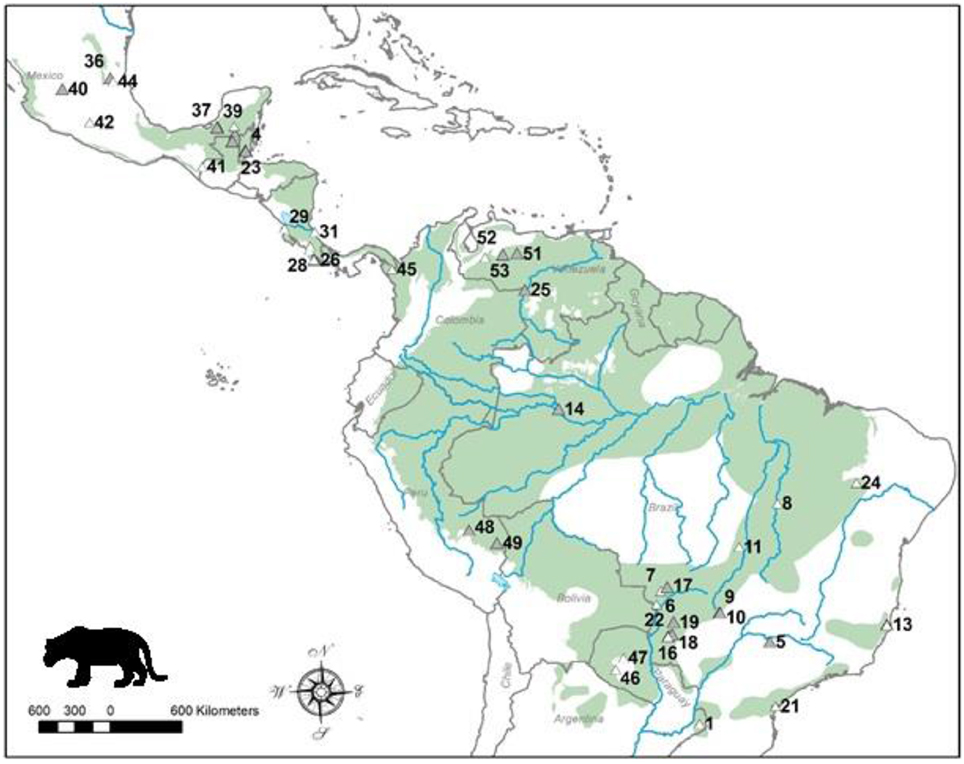Prey Preferences of the Jaguar Panthera onca Reflect the Post-Pleistocene Demise of Large Prey
- 1School of Biological Sciences, School of Environment, Natural Resources and Geography, College of Natural Sciences, Bangor University, Bangor, UK
- 2Centre for African Conservation Ecology, Nelson Mandela Metropolitan University, Port Elizabeth, South Africa
- 3Centre for Wildlife Management, University of Pretoria, Pretoria, South Africa
- 4Wildlife Conservation Research Unit, Department of Zoology, Recanati-Kaplan Centre, University of Oxford, Abingdon, UK
- 5Panthera, New York, NY, USA
- 6Department of Fisheries and Wildlife, Michigan State University, East Lansing, MI, USA
- 7Conservation Biogeography Lab, Ecology Department, Federal University of Goiás, Goiânia, Brazil
- 8Department of Ecology and Evolutionary Biology, University of California, Los Angeles, Los Angeles, CA, USA
Documenting the impacts of the Pleistocene megafaunal extinctions on predator-prey interactions is a challenge because of the incomplete fossil record and depauperate extant community structure. We used a comparative ecological approach to investigate whether the existing prey preference patterns of jaguars Panthera onca were potentially affected by the Pleistocene extinctions in the Americas compared with large felids in Africa and Asia.
Distribution map of the jaguar and location of study sites. Current jaguar distribution is shaded and these data were obtained from the IUCN Red List. Sites where dietary studies of jaguars have been conducted are shown as triangles, and the shaded triangles represent the sites of studies that had data used in the analyses.

We reviewed the literature and found 25 studies reporting 3214 jaguar kills recorded throughout the species' distribution. We found that jaguars significantly preferred capybara Hydrochaeris hydrochaeris and giant anteater Myrmecophaga tridactyla, and avoided agoutis, carnivorans, primates, black-eared opossum Didelphis marsupialis and tapirs.
Jaguar sizing up a Giant Anteater--a preferred prey
Jaguar easily takes an Armadillo
A preferred Jaguar prey-A Capybra being run down
Jaguar sizing up a Giant Anteater--a preferred prey
Jaguar easily takes an Armadillo
Jaguars easily dine on Deer
While not simple, Jaguars will overpower
both Croc's and Caman
A tasty snack--A monkey for the Jaguar
A Tapir,,,,not on the menu as often--but a feast awaits this Jag
Generalized linear models showed that jaguars select prey primarily based on socio-ecological and behavioral traits (abundance and herd size), rather than morphological characteristics (body size).
Nonetheless, their accessible prey weight range was 6–60 kg, preferred prey weight range was 45–85 kg, and mean mass of significantly preferred prey was 32 ± 13 kg leading to a predator to prey body mass ratio of 1:0.53, which is much less than that of other solitary felids (although 1:0.84 may be the relationship with the smallest jaguars).
Compared with other large, solitary felids, jaguars have an unusual predator to prey body mass ratio, show limited effect of prey morphology as a driver of prey selection, lack evidence of optimal foraging beyond their preferred prey, and a lack of preferential hunting on Cetartiodactyla herbivores. These features, coupled with the reduction in jaguar body mass since the Pleistocene, suggest that the loss of larger potential prey items within the preferred and accessible weight ranges at the end-Pleistocene still affects jaguar predatory behavior. It may be that jaguars survived this mass extinction event by preferentially preying on relatively small species.

 Matt W. Hayward
Matt W. Hayward Jan F. Kamler
Jan F. Kamler Robert A. Montgomery
Robert A. Montgomery Anna Newlove
Anna Newlove Susana Rostro-García
Susana Rostro-García Lilian P. Sales
Lilian P. Sales Blaire Van Valkenburgh
Blaire Van Valkenburgh
















No comments:
Post a Comment